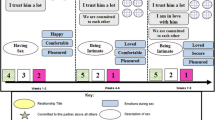Abstract
In 2006, the Centers for Disease Control and Prevention funded seven community-based organizations (CBOs) to conduct outcome monitoring of Healthy Relationships. Healthy Relationships is an evidence-based behavioral intervention for people living with HIV. Demographic and sexual risk behaviors recalled by participants with a time referent of the past 90 days were collected over a 17-month project period using a repeated measures design. Data were collected at baseline, and at 3 and 6 months after the intervention. Generalized estimating equations were used to assess the changes in sexual risk behaviors after participation in Healthy Relationships. Our findings show that participants (n = 474) in the outcome monitoring project reported decreased sexual risk behaviors over time, such as fewer number of partners (RR = 0.55; 95% CI 0.41–0.73, P < 0.001) and any unprotected sex events (OR = 0.44; 95% CI 0.36–0.54, P < 0.001) at 6 months after the intervention. Additionally, this project demonstrates that CBOs can successfully collect and report longitudinal outcome monitoring data.

Similar content being viewed by others
References
Centers for Disease Control and Prevention. HIV prevalence estimates United States, 2006. MMWR. 2008;57(39):1073–6.
Campsmith ML, Rhodes PH, Hall HI, et al. Undiagnosed HIV prevalence among adults and adolescents in the United States at the end of 2006. J Acquir Immune Defic Syndr. 2010;53(5):619–24.
O’Leary A, Wolitski RJ. Moral agency and HIV transmission. Psychol Bull. 2009;135(3):478–94.
Wolitski RJ, Flores SA, O’Leary A, Bimbi DS, Gómez CA. Beliefs about personal and partner responsibility among HIV-seropositive men who have sex with men: measurement and association with transmission risk behavior. AIDS Behav. 2007;11(5):676–86.
Marks G, Crepaz N, Senterfitt JW, Janssen RS. Meta-analysis of high-risk sexual behavior in persons aware and unaware they are infected with HIV in the United States: implications for HIV prevention programs. J Acquir Immune Defic Syndr. 2005;39(4):446–53.
Coates TJ, Richter L, Caceres C. Behavioral strategies to reduce HIV transmission: how to make them work better. Lancet. 2008;372(9639):669–84.
Crepaz N, Marks G, Liau A, et al. Prevalence of unprotected anal intercourse among HIV-diagnoses MSM in the United States: a meta-analysis. AIDS. 2009;23(13):1617–29.
Johnson BT, Carey MP, Chaudoir SR, Reid AE. Sexual risk reduction for persons living with HIV: research synthesis of randomized controlled trials, 1993 to 2004. J Acquir Immune Defic Syndr. 2006;41(5):642–50.
Crepaz N, Lyles CM, Wolitski RJ, et al. Do prevention interventions reduce HIV risk behaviours among people living with HIV? A meta-analytic review of controlled trials. AIDS. 2006;20(2):143–57.
Lyles CM, Crepaz N, Herbst JH, Kay LS. HIV/AIDS Prevention Research Synthesis Team. Evidence-based HIV behavioral prevention from the perspective of the CDC’s HIV/AIDS Prevention Research Synthesis Team. AIDS Educ Prev. 2006;18(4SupplA):21–31.
Collins C, Harshbarger C, Sawyer R, Hamdallah M. The diffusion of effective behavioral interventions project: development, implementation, and lessons learned. AIDS Educ Prev. 2006;18(4SupplA):5–20.
Baskin ML, Braithwaite RL, Eldred L, Glassman M. Introduction to the special supplement: prevention with persons living with HIV. AIDS Educ Prev. 2005;17(1 Suppl A):1–5.
Office of National AIDS Policy. National HIV/AIDS Strategy for the United States. July 2010. http://www.whitehouse.gov/sites/default/files/uploads/NHAS.pdf. Accessed October 15, 2010.
Kalichman SC, Rompa D, Cage M, et al. Effectiveness of an intervention to reduce HIV transmission risks in HIV-positive people. Am J Prev Med. 2001;21(2):84–92.
Collins CB, Hearn KD, Whittier DN, Freeman A, Stallworth JD, Phields M. Implementing packaged HIV-prevention interventions for HIV-positive individuals: considerations for clinic-based and community-based interventions. Public Health Rep. 2010;125(Suppl 1):55–63.
Kalichman SC, Hudd K, DiBerto G. Operational fidelity to an evidence-based HIV prevention intervention for people living with HIV/AIDS. J Prim Prev. 2010;31(4):235–45.
Kalichman SC, Cherry C, White D, Pope H, Cain D, Kalichman M. Altering key characteristics of a disseminated effective behavioral intervention for HIV positive adults: the “healthy relationships” experience. J Prim Prev. 2007;28(2):145–53.
Thomas CW, Smith BD, Wright-DeAguero L. The program evaluation and monitoring system: a key source of data for monitoring evidence-based HIV prevention program processes and outcomes. AIDS Educ Prev. 2006;18(Suppl 1):74–80.
Grinstead OA, Zack B, Faigeles B. Reducing postrelease risk behavior among HIV seropositive prison inmates: the health promotion program. AIDS Educ Prev. 2001;13(2):109–19.
Liang KY, Zeger SL. Longitudinal data analysis using generalized linear models. Biometrika. 1986;73(1):13–22.
Menendez E, White MC, Tulsky JP. Locating study subjects: predictors and successful search strategies with inmates released from a U.S. county jail. Control Clin Trials. 2001;22(3):238–47.
Hall HI, Green TA, Wolitski RJ, et al. Estimated future HIV prevalence, incidence, and potential infections averted in the United States: a multiple scenario analysis. J Acquir Immune Defic Syndr. 2010;55(2):271–6.
Bertozzi SM, Laga M, Bautista-Arredondo S, Coutinho A. Making HIV prevention programs work. Lancet. 2008;372(9641):831–44.
Acknowledgments
We thank the efforts of the CBOP staff at each agency for their support and assistance in conducting this outcome monitoring project. We would also like to thank Stephen Tregear for his statistical consultation and thoughtful review of a previous version of this article. Felicia Hardnett, Brenda Chen, and Venkat Mannam provided valuable statistical assistance and consultation. Input from Eka Shapatava was very helpful in preparing this manuscript.
Author information
Authors and Affiliations
Corresponding author
Additional information
Disclaimer: The findings and conclusions in this report are those of the authors and do not necessarily represent the views of the Centers for Disease Control and Prevention.
Rights and permissions
About this article
Cite this article
Heitgerd, J.L., Kalayil, E.J., Patel-Larson, A. et al. Reduced Sexual Risk Behaviors Among People Living with HIV: Results from the Healthy Relationships Outcome Monitoring Project. AIDS Behav 15, 1677–1690 (2011). https://doi.org/10.1007/s10461-011-9913-2
Published:
Issue Date:
DOI: https://doi.org/10.1007/s10461-011-9913-2




